This is a story about pie, but also not. It’s convoluted and messy, like life. Like a pie that breaks and the filling spills through the crust. I’ve been working on this letter and then sitting on it for some time, not sure if I should/could send it out into the world. But here it is, or rather, here I am. Now, it’s not mine anymore. Do what you will with it.
At the end of this letter, you’ll find pie crust tips and resources because this, again, is about pie. I’m also sharing Ode to Pie: A Poem, which is about pie and, as is the way with this letter, about something else also.
Now that the throat-clearing is out of the way let’s dive in.
Part of this post was originally published on my blog in 2016. I edited lightly for clarity.
While many people learn to bake pie early in life, maybe even standing next to their grandmother’s hip or with a parent, I didn’t know how to bake a great pie until I was in my fifties. I could be considered a slow learner. (Note: why I wrote in 2016 that I was a slow learner shows that I was attempting to be self-deprecating, but it fell flat, and incidentally, I am not a slow learner. I am a quick learner.) Some in the food world, and possibly people in general, might consider not learning to make a pie unfathomable, especially for someone (me) who was once in the business of nurturing others through food.
I didn’t have the privilege of enjoying my grandparents' baking or anything else because they were all deceased when I arrived in the world; I did learn a little about food from my parents. Dad taught me to scramble eggs slowly on low heat, and Mom allowed me to snip dates with kitchen shears and sift flour when she baked her annual Date & Nut Bread for the holidays. But when Dad died, I was seven years old in 1969, and the structure of our family, kitchen, and household went with him.
At a time when Julia Child was revolutionizing French food for many Americans, we clipped coupons. We bought food with S&H Green Stamps: chipped ham, bologna, and the plethora of prepackaged boxed and canned foods of the seventies: Hamburger Helper and La Choy Chicken Chow Mein, which was a bonus for Mom since prepackaged foods revolutionized kitchens like ours across America and liberated our Moms and girls like me, giving us freedom to work and to learn skills other than domestic responsibilities. Not that I would’ve ever volunteered to have less of Mom, but life was what it was.
Once Mom weaned us from welfare supplements, I was a curious teen in the kitchen. Thankfully, my older sister Kathleen taught me to cook pots of chili and spaghetti with red sauce on the electric burner of the avocado green stovetop, tuna noodle casseroles, and Mrs. Paul’s fish sticks in the oven on Fridays. I scoured The Good Housekeeping Cookbook, deciphering notes in the margins and sauce-splattered recipes — tips from Dad, written in pen, hard lines versus Mom’s soft, flowing cursive in pencil. Kevin, my older brother, a culinary school graduate, would return home on weekends. He taught me how to poach vegetables and to use knives. “Curl your knuckles, fingertips down.” He taught me to clarify butter and sear blackened redfish in a cast iron skillet.
Pie wasn’t on our weekly menu other than Pumpkin Pie during Thanksgiving. We were cake people — specifically, sheet cakes from Duncan Hines. A sheet cake portions evenly and feeds a crowd because, besides our family of thirteen, our friends, who Mom taught us to treat like family, were often at the table in our tiny kitchen with buttercream yellow walls and sheer, frilly curtains. Mostly, though, growing up, food was an issue for me. I was content to prepare food, but when food is scarce, rigidly portioned, or unevenly distributed, you don’t learn how to manage what or how you eat. Pile on trauma, and all sorts of problems rise to the surface.
My not wanting to learn to bake pie wasn’t only economics or emotions, though. I ran from every aspect of my traditional Catholic upbringing, where marriage, babies, and managing a household made me bristle just thinking about it. Food became an afterthought, sustenance, not luxury. Pie, in essence, was a luxury. I didn’t give food much thought until the refrigerator was bare, and then the rushing humiliation of not having enough flooded me with shame.
Strangely, and ironically, in my late twenties through late thirties, I stood in front of two three-foot hot griddles managing a sixty-four-seat breakfast and lunch restaurant, battling with the very thing I had been running from: food and structure.
In that 2,000-square-foot diner, I learned that food was the conduit I needed for personal growth. Amidst fluctuating temperatures on the electric griddle, grease popping on my arms and face from the gas griddle, nonstop tickets piled on the spindle, and employees who arrived late for their shift or not at all, I evolved. Theft. A clogged septic system. Inventory. A nonstop gurgling coffee pot. Amidst banana pancakes, bacon, and over ten years, more than 125,000 eggs, I grew up. I paid to patch the roof and repair the parking lot. I nurtured customers who were never satisfied and customers who ate whatever I cooked for them. I served pre-dawn coffee-to-go to boat captains and their wealthy clients who were always in a rush and locals who sat around well after their plates were washed and stacked, taking up precious space when another turn was what I desperately needed to make payroll.
Even though I was immersed in the food world — cooking, baking, and managing a restaurant for people standing in line around the building seven days a week — pie was neither on the menu nor in my diet. It was personal. I didn’t do moderation well then, and I worked to maintain a healthy body so I could snow ski in Italy, France, and Argentina with my then-fiance. I was also preoccupied with proving something to myself and the entire community. I was the stranger who came to town without any previous restaurant experience. I knew nothing about the comfort of tradition.
One afternoon in the early years of my tenure, Charlie, one of my “Snowbird regulars,” a term used to describe anyone who wintered in Marathon from mid-October until Easter, slid onto a barstool at the counter behind my grills. Charlie was a tall, large, quiet man with a head of silver hair and small blue eyes on the early side of milky. He rested his wrinkled, sun-damaged forearms on the bar.
“Young lady,” he said as he always did (Charlie never called me Maureen or Moe, which, to my irritation, was what everyone called me back then), “Why don’t you have key lime pie on the menu?”
That day, I was between breakfast and lunch service and needed a break from the front of the house. I needed to check on my dishwashers, one prone to peddling weed out the back door, and everything I needed to manage in the back of the house: food prep and inventory. It was a valid question. A tricky question. One I wanted to ignore, and it wasn’t the first time Charlie or numerous customers had asked it. But I was living a life of avoidance: food (pie), feelings (love), and an uncomfortable truth (my engagement was doomed from the beginning: he was a wealthy, older Jewish man to my youth and inexperience, plus I was raised Catholic). But it was more than that, too. But the funny thing is, I didn’t go anywhere that day. I knew Charlie wouldn’t be around long, and he’d eventually ask me the next time he made it into the restaurant anyway. I made no excuses, actual or concocted. There was the matter of my anger, too, so I took a leap of faith and lobbed my statement of fact like pitching a softball to a child. I leaned on the bar and said, “I don’t like the recipe for the key lime pie on the menu.”
There. I said it. You see, I’d inherited the restaurant from a couple who did many things to sabotage my success. I had worked to elevate the joint as much as possible without losing the regulars while working to appease the tourists and snowbirds. I also worked to up my game as a young restauranteur and tried to maintain my temper when the world was on fire around me, and in the process, I did not want to give anyone food poisoning. The pie on the menu was a no-bake custard concoction, and I was suspicious of raw eggs in anything. I wasn’t sure if the couple was messing with me when we discussed the ingredients and chemistry of serving a key lime pie made with raw eggs. I had more on my plate than to worry about a pie. Not having key lime pie on the menu was a practical consideration, too. Every restaurant in the Florida Keys had a Key Lime Pie on the menu, so why, I rationalized, did I need one too? I wasn’t eager to add another food item to the already laborious and bloated menu I’d acquired. People wanted brownies in their box lunches for boat trips, not Key Lime Pie.

That day, as the busser worked around me to fill the silverware bins and the kitchen bell in the pass-through window rang out, Charlie reached into his shirt pocket and removed a slip of paper, folded once, white with blue lines. On it, his version of key lime pie, written in neat capital letters in pencil, a no-bake, no-egg, graham-cracker crust version.
I religiously made Charlie’s Key Lime Pie until I hung up my apron.
And now, if you were expecting Charlie’s Key Lime Pie recipe, this is a heartbreaking part of the story. When I walked away from that life after ten years, I left Charlie’s recipe and everything else, including two marriage engagements and a slice of my broken heart, in that tiny restaurant on U.S. Hwy 1 in Marathon, Florida.
(Note: Key Limes are smaller and more round (about the size of a golf ball or less) than traditional limes. They’re also more tart and often have thin, yellowish-chartruese-colored skin. If you’ve never eaten Key Lime Pie, here’s the traditional recipe from Joe’s Stone Crab Key Lime Pie, similar to the pie I refused to make for my restaurant. If you can’t find fresh key limes, substitute them with Nelly & Joe’s Famous Key West Lime Juice, which is found in most grocery stores in the US.)
For the next several years, the only pie in my life was the pre-made variety I sold to chefs in the commercial food industry. Frozen, ready-to-bake from a cardboard box kind-of-pies. I only had to show the clients how to thaw, slice, and serve, or bake dozens of Sara Lee fruit pies in massive industrial kitchens or display them in humongous convention center trade shows with a number ten scoop of Crisco that looked strangely like a scoop of ice cream, because people browsing food shows want to eat what they see. We couldn’t display ice cream for ten hours anyway. My job was simple: show chefs and cooks how to prevent the crust from burning with a pie crust shield that I would also sell them. Pie was reduced to a commodity and typical sales fundamentals: ABC, Always Be Closing.
I was in my early fifties when we (my first husband of three years) moved to Madisonville, a small rural town in western Kentucky. The first trip we made from Orlando before we packed all the furniture involved a pit stop in a country store in Tennessee, where I first encountered handheld pies of every variety. I bought one, like a novelty. Apple cinnamon with an icing glaze. I devoured it before we hit the four-lane. On the next trip, I bought one of every available variety: chocolate, cherry, apple, peach, and lemon meringue. I was more judicious the second time, savoring the pies over the next week — a bite here and there.
But once again, as when I managed the restaurant in Florida, I found myself in unfamiliar territory in western Kentucky. I was without my decades-long Florida friends and food community. With too much time on my hands and a healthy dose of relocation depression, I leaned into baking pies.
Fruit, sugar, acid, flour, butter, salt. How difficult can pie be?
The math was simple: Fold butter and sugar into the fruit + fraisage (smear butter through flour) + fill and fold, then bake until bubbling and golden brown = flakey, warm, comfort.
Julia Child was rarely wrong.
Since more than half of my life had passed, I made it halfway through life without pie! A travesty! I would make up for lost time. I deserved to eat pie like any other human. But of all the things I deserved: fair compensation for an essay and recipe in a magazine, respect, and fundamental rights as a woman, pie should not have been a negotiable item on the list of things I deserved in life.
ODE TO PIE
Yes, I deserve the guilty pleasures
from a slice of warm, fruity, tender pie
out of the oven
even though
I know it's better
to let it
cool
before slicing.
Yes, I deserve
to spend time
kneading
every so lightly.
Sprinkling silky flour
on a board,
rolling
out the dough
with a feathery touch.
Piling fruit in the center,
then,
crimping
and folding
like a kiss
from an angel
Savoring the moment
with a book
and a cup of tea,
when the heat from the oven
melts butter
into salted flour
when the air is perfumed
with the blending of sweet berries
or apples
or peaches
cinnamon and caramelized sugar.
Pie
equals self-love,
actualized
between layers
of pastry,
sweetened fruit
and the memories of a well-lived life.
Pie Crust Tips:
Great pie crust comes from experience, a light touch, and cold, cold, cold, quality ingredients: the silky soft texture of fine flour, the rich and creamy tang of buttermilk* (sour cream is an excellent option, too), and no shortage of full-fat frozen butter, plus a solid crust technique. All play an important role. *If you don’t have buttermilk or sour cream, mix vinegar or lemon with milk: One cup of milk with one tablespoon of acid (white vinegar or lemon juice).
On technique: The best tip is not to overwork the crust. Fraisage means smearing the butter into the flour with the heel of your hand. I dropped a video of pastry chef Dorie Greenspan in the resources section.
After egg-washing the crust, chill the pie in the refrigerator for fifteen to twenty minutes before baking it. A whole egg wash with a few drops of water produces a golden crust, while an egg-white wash with water produces a pale, delicate crust. I sprinkle cane sugar over the wash before I bake the pie.
On style and baking: I prefer rough, freeform one-crust pies over the traditional two-crust pies because they’re quicker and more forgiving. But bake pie however your heart desires! You can bake your galette with a baking sheet, cast iron skillet, pie tin, or nine-inch cake pan. I always use a pastry sheet underneath, regardless of what container I use. Bake at 450 for fifteen minutes, then reduce to 350 for 40-50 minutes, rotating halfway through the bake in the center of the oven.
On flour: I have used several types of flour to make a crust. My favs (this is not a product endorsement) are White Lily All-Purpose, Bob’s Red Mill pastry flour, and King Author Cake Four. The key to these flours is their silky, soft, light texture. I don’t sift my flour or measure by scale, but I do whisk the dry ingredients. Note: I’m not a pie purist or pastry chef. Most chefs and home cooks never bake a pie without weighing the dry ingredients. I get it. But that’s not what this is about.
On filling the crust with fruit: Before I place the fruit on the pie crust, I smear a tablespoon of orange marmalade across the surface of the center of the crust and sprinkle a tablespoon or two of plain panko breadcrumbs over the marmalade to help absorb the juice from the fruit. Then I add the fruit. I don’t remember where I learned this tip, but it works. I use whatever fruit is in season or my freezer. Delicious fruit combos include blueberry, raspberry, strawberry, peach and raspberry, or pear and apple. Think figs and cheese. Fruit pie combinations are endless!
If you enjoy savory flavors over sweet, try spinach and asparagus with Parmesan Reggiano or tomato, eggplant, herbs, and goat cheese (above). Sweet sausage, kale, and caramelized onion with feta make a delicious meal.
Pie Resources:
Pie School by Kate Lebo
The Hungry Traveler, Always Taste Pie Filling Before Baking
Smitten Kitchen, Pie Crust 101
Thank you so much for reading and being here. It is a privilege to be in your inbox, and I am grateful. Now it’s your turn: Do you have a favorite pie recipe, a pie crust secret handed down, or a tip you learned by trial and error? Please drop a note in the comments or feel free, as always, to reply to this letter to keep things private. I love hearing from you.
Feel free to share this post and spread the pie love because life’s too short not to eat pie.
Talk soon,
Maureen xo
Stay curious. Stay safe. Make an impact.


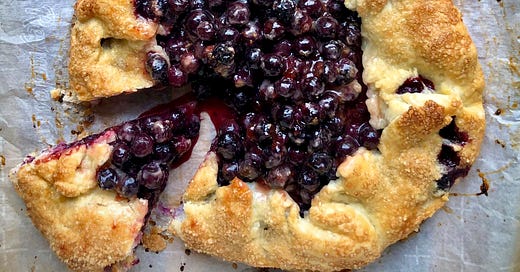




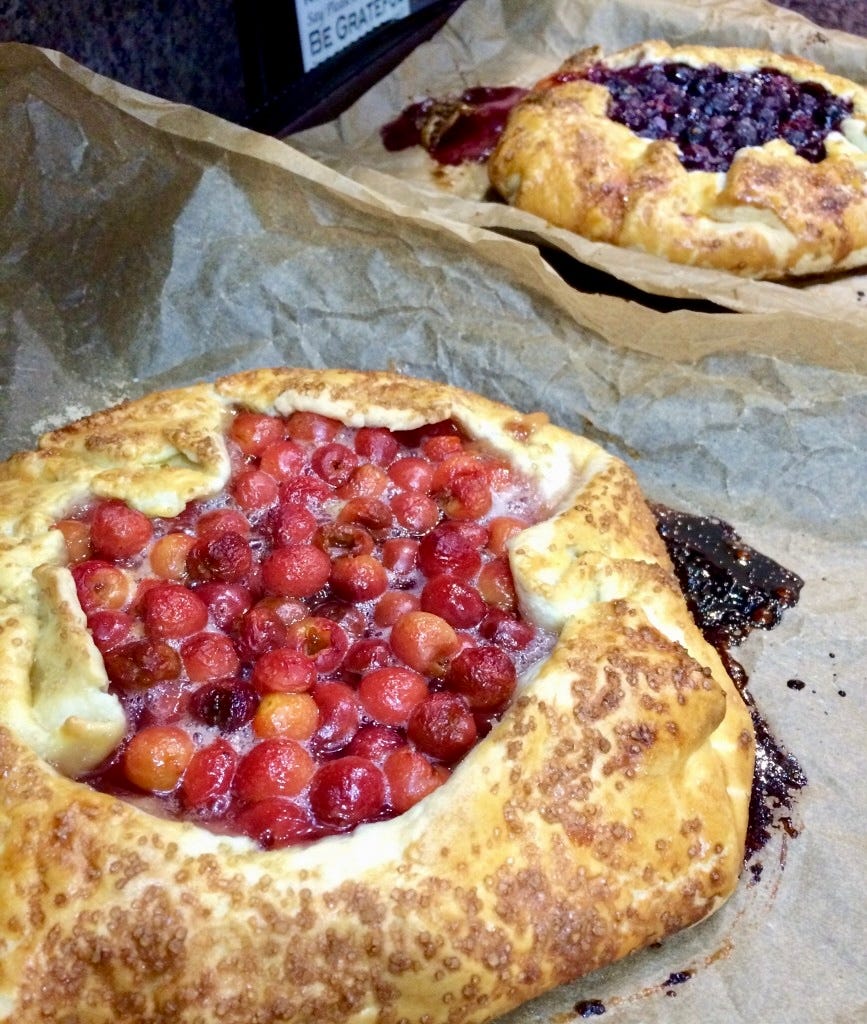
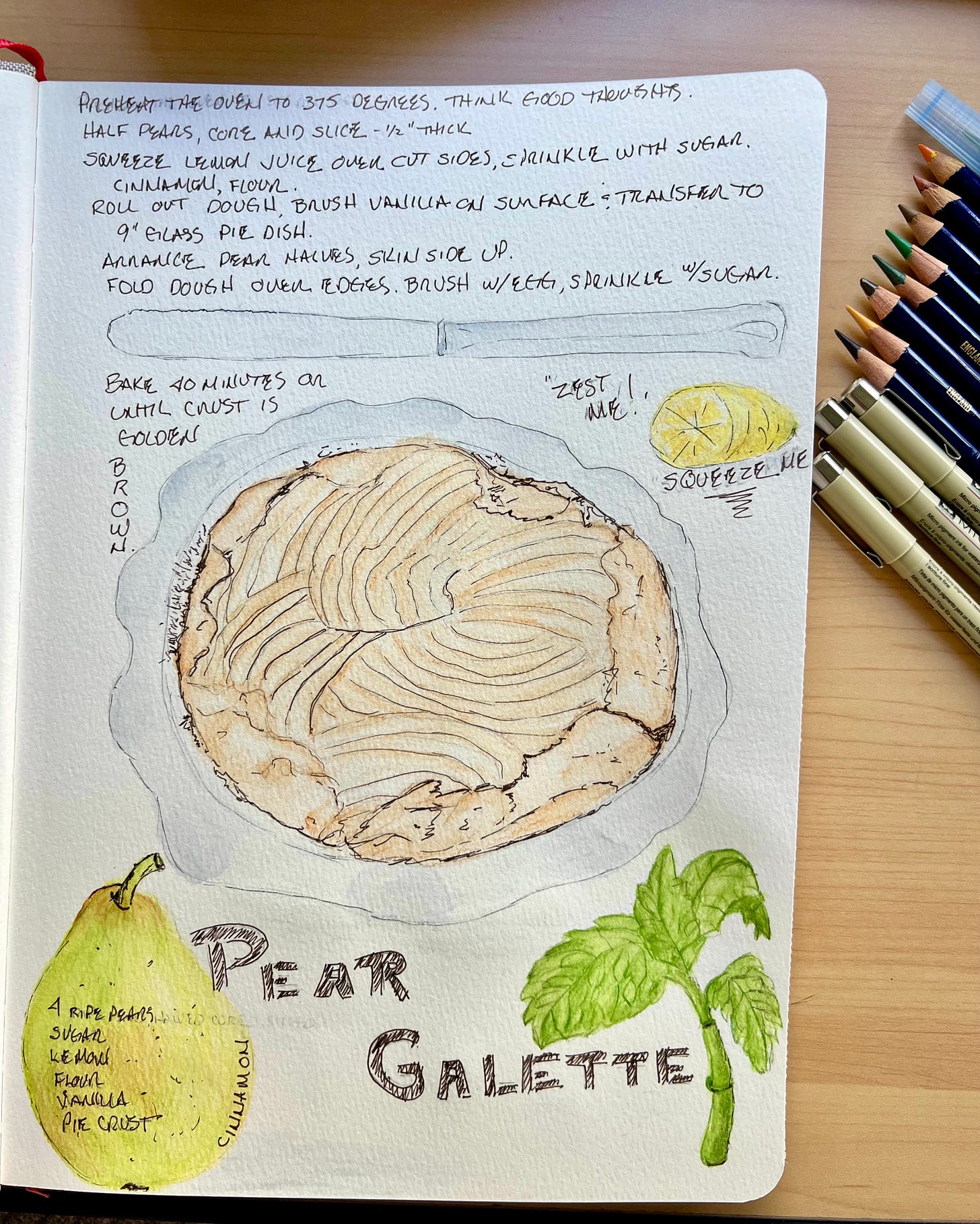
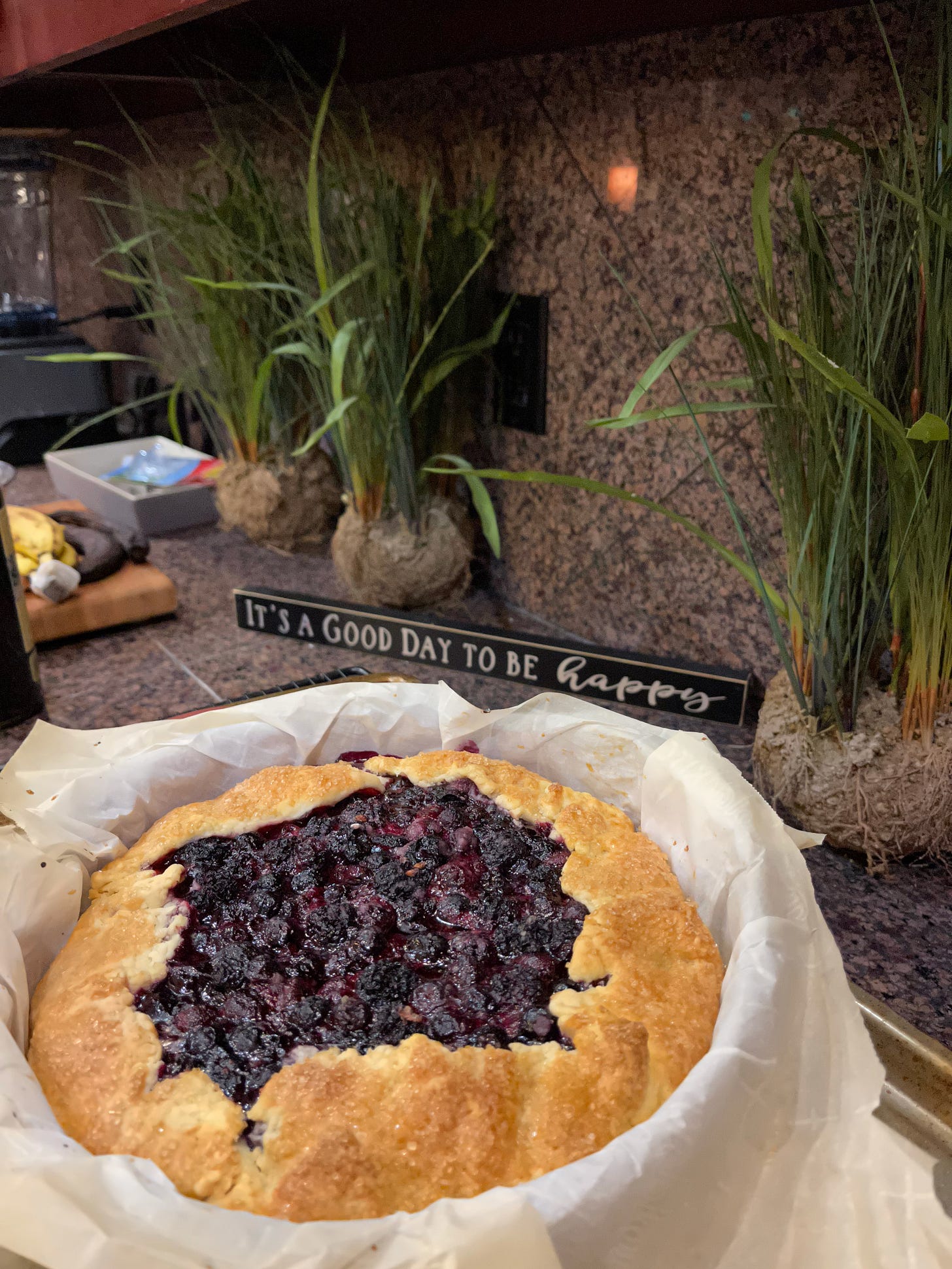

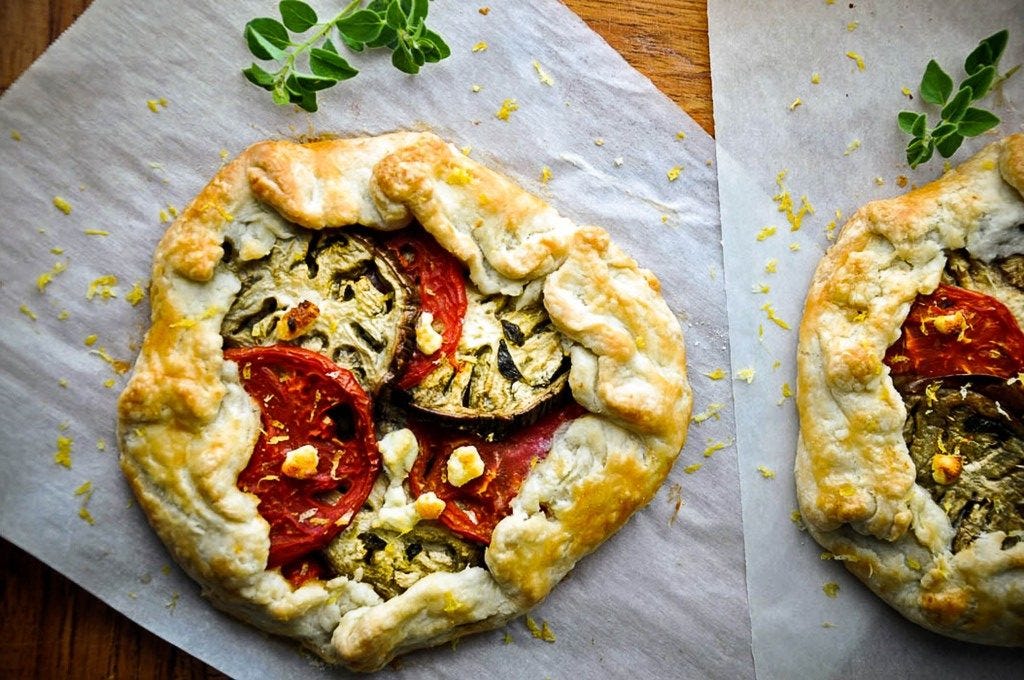

First up I absolutely love that photo of Cooper, it definitely made me laugh. Very rarely would I make a fruit pie, but over the years I have made many meat pies, my reasoning being that store bought pies are very mean with the lack of ingredients and flavour. I thoroughly enjoyed your post today, and for the heads up regarding to making great pastry.
Enjoyed that read very much though it made me hungry. Also watched the Julia Child video, that was great!👍🏻💐